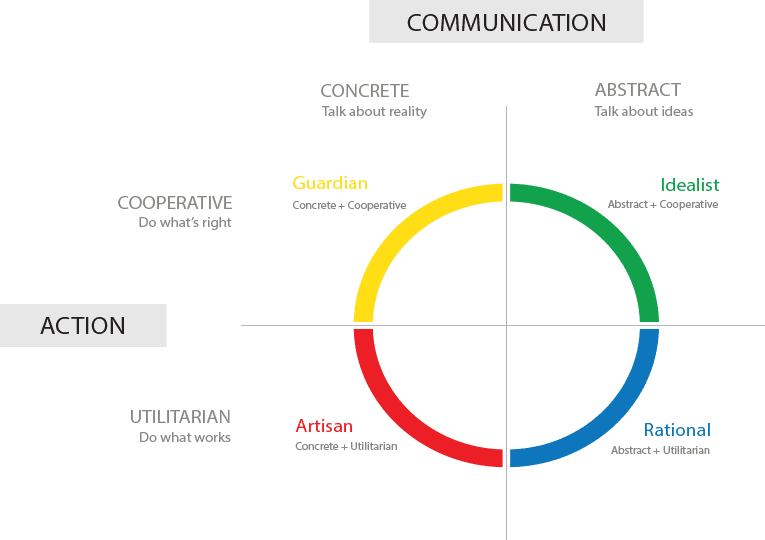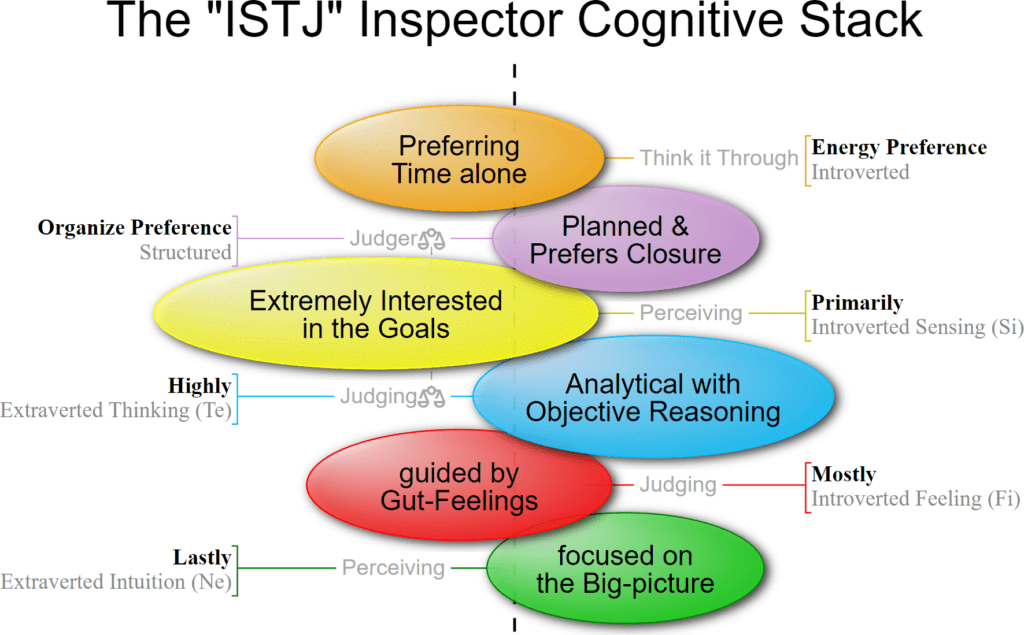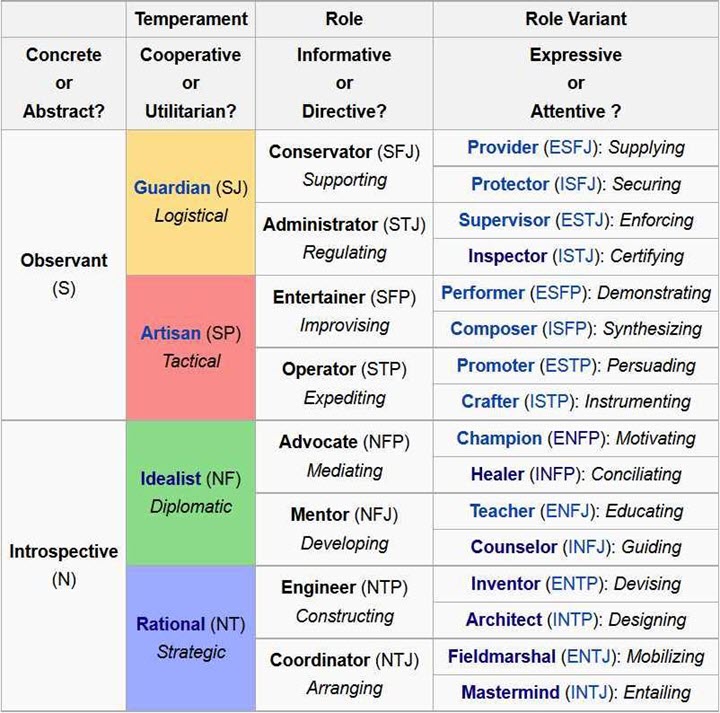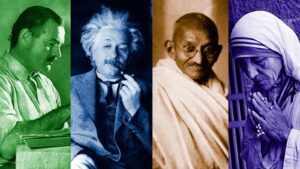What is the Keirsey ISTJ “Inspector” Personality Type?
The Keirsey ISTJ “Inspector ” Personality Type is a Guardian Temperament with a Concrete Communication Style and a Cooperative Action Style.
Keirsey organized the Four Temperaments as a matrix. There are two communication styles, abstract and Concrete, similar to the Myers-Briggs Intuition (Abstract) and Sensing (Concrete) “Perceiving” Cognitive Functions.
And by two action styles: cooperative and utilitarian. Utilitarian people, for the most part, do what works, while Cooperative people do what’s right.
Keirsey named the Four Temperaments as suggested by Plato: Artisan (Iconic), Guardian (Pistic), Idealist (Noetic), and Rational (Dianoetic).

Concrete versus Abstract Communication Style
Keirsey divided the Four Temperaments into two Communication Styles: Abstract and Concrete. These styles are similar to the Myers-Briggs Intuition and Sensing “Perceiving” Cognitive Functions.
Some people talk primarily about everyday reality’s external, concrete world: facts and figures, work and play, home and family, news, sports, and weather—all the who, what, when, where, and how of life.
Other people talk primarily about the internal, abstract world of ideas: theories and conjectures, dreams and philosophies, beliefs and fantasies—all the whys, ifs, and what might be of life.
In their daily lives, Concrete people talk about reality, while Abstract people talk about ideas.
According to Keirsey, everyone can engage in both observation and introspection. People are observant when they touch objects or otherwise perceive the world through their five senses. When people reflect and focus on their internal world, they are introspective. However, individuals cannot engage in observation and introspection at the same time. The extent to which people are more observant or reflective affects their behavior.
People who are generally observant are more ‘down to earth.’ They are more concrete in their worldview and focus on practical matters such as food, shelter, and their immediate relationships. Carl Jung used the word sensation when describing people who prefer concrete perception.
Generally, reflective people have more ‘head in the clouds’ and more abstract worldviews. They focus on global or theoretical issues such as equality or engineering. Carl Jung used the word intuition to describe people who prefer abstract perception.
Cooperative versus Utilitarian Action Style
Some people act primarily practically or pragmatically; that is, they do what gets results, what achieves their objectives as effectively or efficiently as possible. They only check afterward to see if they observe the rules or go through the proper channels.
Other people act primarily cooperatively or socially acceptable; they try to do the right thing in keeping with agreed-upon social rules, conventions, and codes of conduct. Only later do they concern themselves with the effectiveness of their actions.
These two ways of acting can certainly overlap, but as they lead their lives, utilitarian people mostly do what works, while cooperative people do what’s right.
Keirsey compares the differing temperaments with cooperative (Complying) and pragmatic (Adaptive) temperaments. Cooperative people pay more attention to other people’s opinions and are more concerned with doing the right thing. Sensible people (Utilitarian) pay more attention to their thoughts or feelings and are more concerned with doing what works. No comparable idea in the MBTI or Jung corresponds to this dichotomy, a significant difference between Keirsey’s work and Myers and Jung’s.
The pragmatic temperaments are Rational (pragmatic and abstract) and artisan (Pragmatic and concrete). The Cooperative Temperaments are Idealists (Cooperative and Abstract) and Guardians (Cooperative and Concrete). Neither the MBTI nor Jung included the concept of Temperament in their work.
ISTJ Keirsey/MBTI Correlation
| Keirsey | MBTI | |
|---|---|---|
| I | Attentive Role Variant | Introverted Sensing |
| S | Concrete Communication Style | Dominate Introverted Sensing Function |
| T | Directive Role | Auxiliary Extraverted Thinking Function |
| J | Cooperative Action Style | Thinking is a Judging Function |
With Introverted Sensing as the dominant function and Extraverted Thinking as the auxiliary function, the MBTI ISTJ “Inspector” personality type corresponds to the Keirsey ISTJ “Inspector” personality type.

ISTJ Personality Type cross-reference
- Keirsey Type – Inspector
- Temperament Type – Melancholy
- Animal Type – Beaver
- DISC Type – Compliant
- Socio-Communicative Type – Analytical
- True Colors – Gold
- Color Code – White
- Personality Compass – East
- Occupational Type – Realistic
- Learning Type – Pragmatist
- Leadership Type – Avoider
Enneagram Types
Inspector Personality Characteristics
The one word that best describes Inspectors is super dependable. They are extraordinarily persevering and dutiful, whether at home or work, mainly when examining the people and products they are responsible for.
In their quiet way, Inspectors see that rules are followed, laws are respected, and standards are upheld.
Inspectors (as much as ten percent of the general population) are the true guardians of institutions.
They are patient with their work and the procedures within an institution, although not always with some people’s unauthorized behavior.
Responsible to the core, Inspectors like it when people know their duties, follow the guidelines, and operate within the rules.
For their part, Inspectors will ensure that goods are examined, schedules are kept, and resources are up to standards and delivered when and where they are supposed to be. They would prefer that everyone be this dependable.
Inspectors can be hard-nosed about the need to follow the rules in the workplace and do not hesitate to report irregularities to the proper authorities. Because of this, they are often misjudged as being hard-hearted or having ice in their veins, for people fail to see their good intentions and vulnerability to criticism.
Also, because inspectors usually do their inspections without much flourishing or fanfare, their dedication to their work can go unnoticed and unappreciated.
While not as talkative as Supervisor Guardians [ESTJs], Inspectors are still highly friendly.
They will likely be involved in community service organizations, such as Sunday School, Little League, or Boy and Girl Scouting, that transmit traditional values to the young.
Like all Guardians, Inspectors hold dear their family social ceremonies-weddings, birthdays, and anniversaries – although they tend to be shy if the occasion becomes too large or too public.
Generally speaking, Inspectors are not comfortable with anything that gets too fancy.
Their words tend to be plain and down-to-earth, not showy or high-flown; their clothes are often simple and conservative rather than of the latest fashion; and their home and work environments are usually neat, orderly, and traditional, rather than trendy or flashy.
For personal property, inspectors usually choose standard items over models loaded with features and often try to find classics and antiques. They always prefer the old-fashioned to the newfangled.
Famous Inspectors
Queen Elizabeth II, Harry S. Truman, Warren Buffet, Queen Victoria, James K. Polk, and J.D. Rockefeller are examples of Inspector Guardians.

What are the Keirsy Personality Temerpaments?

David Keirsey, born in 1921, was an American psychologist specializing in conflict management and family counseling. He began researching human behavior and Personality in the 1940s.
Keirsey blended the Myers-Briggs Personality Types with Ernst Kretschmer’s model of the Four Temperaments, developing the Keirsey Temperament Sorter, which was made famous by his book “Please Understand Me.”
Instead of using the term Personality, Keirsey used Temperament. He viewed it as a configuration of observable Personality Traits, communication habits, patterns of action, characteristic attitudes, values, and talents. To Keirsy, Temperament encompasses personal needs, individual contributions, workplace contributions, and societal roles.
Keirsey correlated the sixteen MBTI Personality Types into Four Temperaments. He divided each Temperament into two Roles: informative and Directive. He subdivided the roles into expressive (extraverted) and attentive (introverted) role Variables.
Informative versus Directive Roles
Keirsey distinguishes between people who generally communicate by informing others versus those who speak by directing others. This distinction subdivides each of the four Temperaments into eight Roles.
Expressive versus Attentive Role Variants
Individuals who act before observing are Expressive. In contrast, people who follow before working are Attentive.
Expressive and attentive variants further subdivide the eight roles into 16 types correlating to the 16 Myers-Briggs personality types.


